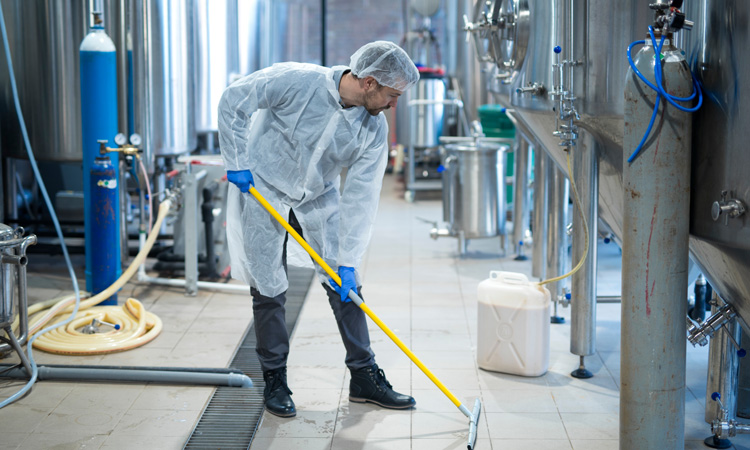The role of cleaning and disinfection in microbiological control
- Like
- Digg
- Del
- Tumblr
- VKontakte
- Buffer
- Love This
- Odnoklassniki
- Meneame
- Blogger
- Amazon
- Yahoo Mail
- Gmail
- AOL
- Newsvine
- HackerNews
- Evernote
- MySpace
- Mail.ru
- Viadeo
- Line
- Comments
- Yummly
- SMS
- Viber
- Telegram
- Subscribe
- Skype
- Facebook Messenger
- Kakao
- LiveJournal
- Yammer
- Edgar
- Fintel
- Mix
- Instapaper
- Copy Link
Posted: 8 February 2020 | Peter Littleton | 1 comment
In any form of food, dairy or beverage operations, one of the key microbiological controls is the correct and thorough application of cleaning and disinfection regimes, states Peter Littleton, Vice-Chair and Training Services Director of the Society of Food Hygiene and Technology (SOFHT).


In my day job, we routinely are called upon to assist with the design, implementation and evaluation of successful cleaning and disinfection interventions to ensure that both pathogenic and spoilage organisms are managed, and the risk of food contamination is reduced or eliminated.
Many people look for complex or highly technical solutions to achieve microbiological controls, however it is often the basics that will bring the greatest contribution to the management of contamination and ensure the safe production or handling of food. This is true from an SME through to a multinational supplying the UK’s food retailers, and the fundamentals of control are common across all businesses.
Effective resourcing, both in terms of equipment and personnel, are essential as well as planning of cleaning activities to ensure that reservoirs or sources of bacterial contamination are accessed and removed along with the sources of nutrients they will need to survive and proliferate. This removal of debris will then enable an effective application of disinfectant which will have a chance to reach any remaining populations. A common error is for debris to remain on surfaces which can act as a protective barrier shielding bacterial populations and preventing access by the biocidal products resulting in survival, proliferation and, in some cases, the formation of a biofilm which can be difficult to successfully remove without the use of additional detergent products and protracted cleaning times.
The establishment of bacterial populations, in and of itself, is rarely a problem unless this has been allowed to occur on food contact surfaces or in a zone where direct contamination is likely and possible. Methods of translocation of bacterial populations from the reservoir point to contact surfaces must be identified and managed.
Effective resourcing, both in terms of equipment and personnel, are essential as well as planning of cleaning activities to ensure that reservoirs or sources of bacterial contamination are accessed and removed
For example, the primary vehicles of hands and personnel should be encouraged as part of the food safety culture training to adopt excellent standards of hygiene and to actively short-circuit the cycle of transfer that can occur from source to surface. Whilst secondary vehicles such as control panels or cleaning utensils must be assessed and subjected to as rigorous a regime of cleaning and disinfection as the food contact surfaces themselves to avoid them becoming an issue. Once again, the emphasis is on management, awareness and planning to reduce the populations that can build-up on these secondary vehicles through effective cleaning and disinfection.
In too many case studies, across all sectors of our industry, a failure of the cleaning and disinfection regime has been implicated or confirmed as the root cause of a microbiological contamination incident
Verification and monitoring of hygiene regimes are as crucial as the correct choice of both detergents and disinfectants with all involved being fully aware of exactly what the results of any test technologies are telling them and the implications to food safety. Whether a simple colour change spray which reveals contamination, or an instrument based system, such as bioluminescence, is used to quantify the amount of ATP present and therefore a non-specific reading of the organic material present after cleaning is employed, the verification of hygiene is part of ensuring that the food safety KPI’s are met.
Organisations such as The Society of Food Hygiene and Technology (SOFHT) and Campden BRI can help to raise awareness and provide valuable, independent advice through their training courses, guidelines and projects. In particular, a revised edition of Guideline 55 on Cleaning & Disinfection from Campden BRI is about to be published which has been developed by an industry group, including SOFHT, to provide practical advice on all aspects of this vital food safety maintenance operation from choosing the right detergent, through planning the cleaning to ensuing that the tools and equipment used do not themselves cause an issue.
In too many case studies, across all sectors of our industry, a failure of the cleaning and disinfection regime has been implicated or confirmed as the root cause of a microbiological contamination incident often with tragic consequences. Hygiene has, in the past, been regarded as something we have to do – I would argue that cleaning and disinfection is a vital link in the food safety chain and should be viewed as such.
About the author
Peter Littleton is Vice-Chair and Training Services Director for the Society Of Food Hygiene and Technology (a voluntary role in addition to his day job). In this position, Peter’s enthusiasm and commitment has led to an engagement with industry, enforcement and special interest groups to address the issue of consumer safety with regard to the management of food safety and hygiene within food, beverage and dairy manufacturing / processing operations.
During his 30 year career involved with the food industry, Peter has worked in the canning, poultry and ready to eat salad sectors in a variety of technical, hygiene and production based roles as well as serving as Senior Food Safety Officer for an environmental health food safety department where he was involved in drafting some of the food legislation in force today.
Related topics
Contaminants, Food Safety, Health & Nutrition, Hygiene, Lab techniques, Outbreaks & product recalls










Food spoilage organisms (not pathogens) from each industry (food, beverage, poultry, vegetables and fruits, dairy) needs to be researched more extensively. There are few publications about the losses they cause to food production because of the difficulties in reporting, collecting and reporting the information. The only information is from food recalls. Do we have any reviews on the subject?